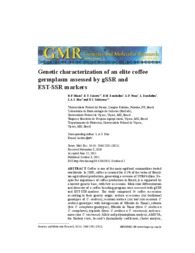Genetic characterization of an elite coffee germplasm assessed by gSSR and EST-SSR markers.
Genetic characterization of an elite coffee germplasm assessed by gSSR and EST-SSR markers.
Author(s): MISSIO, R. F.; CAIXETA, E. T.; ZAMBOLIM, E. M.; PENA, G. F.; ZAMBOLIM, L.; DIAS, L. A. S.; SAKIYAMA, N. S.
Summary: Coffee is one of the main agrifood commodities traded worldwide. In 2009, coffee accounted for 6.1% of the value of Brazilian agricultural production, generating a revenue of US$6 billion. Despite the importance of coffee production in Brazil, it is supported by a narrow genetic base, with few accessions. Molecular differentiation and diversity of a coffee breeding program were assessed with gSSR and EST-SSR markers. The study comprised 24 coffee accessions according to their genetic origin: arabica accessions (six traditional genotypes of C. arabica), resistant arabica (six leaf rust-resistant C. arabica genotypes with introgression of Híbrido de Timor), robusta (five C. canephora genotypes), Híbrido de Timor (three C. arabica x C. canephora), triploids (three C. arabica x C. racemosa), and racemosa (one C. racemosa). Allele and polymorphism analysis, AMOVA, the Student t-test, Jaccard?s dissimilarity coefficient, cluster analysis, correlation of genetic distances, and discriminant analysis, were performed. EST-SSR markers gave 25 exclusive alleles per genetic group, while gSSR showed 47, which will be useful for differentiating accessions and for fingerprinting varieties. The gSSR markers detected a higher percentage of polymorphism among (35% higher on average) and within (42.9% higher on average) the genetic groups, compared to EST-SSR markers. The highest percentage of polymorphism within the genetic groups was found with gSSR markers for robusta (89.2%) and for resistant arabica (39.5%). It was possible to differentiate all genotypes including the arabica-related accessions. Nevertheless, combined use of gSSR and EST-SSR markers is recommended for coffee molecular characterization, because EST-SSRs can provide complementary information.
Publication year: 2011
Types of publication: Journal article
Unit: Embrapa Coffee
Observation
Some of Embrapa's publications are published as ePub files. To read them, use or download one of the following free software options to your computer or mobile device. Android: Google Play Books; IOS: iBooks; Windows and Linux: Calibre.
Access other publications
Access the Agricultural Research Database (BDPA) to consult Embrapa's full library collection and records.
Visit Embrapa Bookstore to purchase books and other publications sold by Embrapa.

